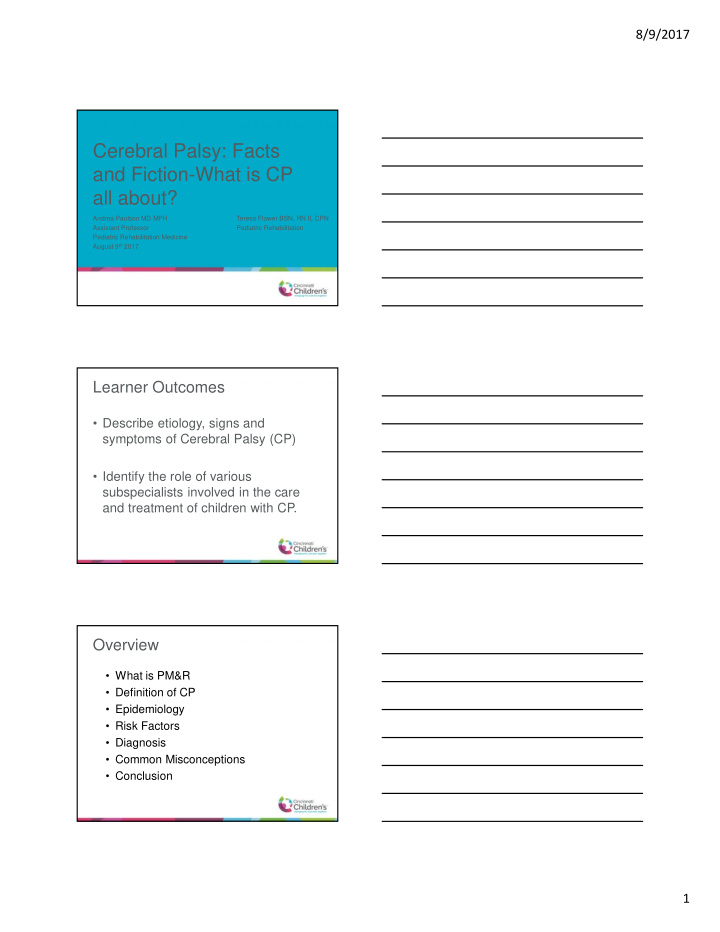



8/9/2017 Cerebral Palsy: Facts and Fiction-What is CP all about? Andrea Paulson MD MPH Teresa Flower BSN, RN II, CPN Assistant Professor Pediatric Rehabilitation Pediatric Rehabilitation Medicine August 9 th 2017 Learner Outcomes • Describe etiology, signs and symptoms of Cerebral Palsy (CP) • Identify the role of various subspecialists involved in the care and treatment of children with CP. Overview • What is PM&R • Definition of CP • Epidemiology • Risk Factors • Diagnosis • Common Misconceptions • Conclusion 1
8/9/2017 What is PM&R? Primary Care Physician Other Family specialists Physical Nursing Therapy Patient and PM&R Physician Dietician Occupational Therapy Social Speech Work Therapy Vision Therapeutic Therapy Recreation What is PM&R? Equipment Family Bracing Development Modifications screening Patient and PM&R Physician School Spasticity Management Work Support Housing system setup Cerebral Palsy (CP) “A group of disorders of the development of movement and posture, causing activity limitations that are attributed to nonprogressive disturbances that occurred in the developing fetal or infant brain” 2
8/9/2017 Epidemiology • CP is the most common motor disability of childhood • Prevalence of 3.6 cases per 1000 children Meet Gage Risk Factors Prematurity • Gestational Age – Born <26 wks - 12% of infants • Birth weight • Prevalence Birth weight 1.4 >2500g 15 1500-2499g 68 1000-1499g 57 <1000g 3
8/9/2017 Risk Factors • Poor APGAR scores – 93-95% with APGAR 0-3 do not have CP • Neonatal Encephalopathy – Outcome depends on HIE severity • Mild: 0-3% sequela • Moderate: 20-35% sequela • Severe: universal sequela Risk Factors • Congenital Abnormalities: – More common in children with CP • Brain Malformations: Occur during development Risk Factors • Genetic susceptibility • Multiple Births: – CP risk increases w/ multiple births • Single 1.6/1000 • Twins 7.3/1000 • Triplets 28/1000 4
8/9/2017 Risk Factors • Stroke • Intracranial hemorrhage • Intrauterine infection • Acquired postnatal causes Gage Gage 4 Days 3.5 Weeks Intracranial Hemorrhage 5
8/9/2017 Diagnosis • Relies upon a combination of findings, including motor delay, neurologic signs, persistence of early developmental reflexes, and abnormal postural reactions • There are no specific tests to confirm the diagnosis of CP • The general algorithm Goal of Diagnosis • Goal for Diagnosis and referral as early as a concern arises. • Need for a team approach, Physical Medicine and Rehabilitation Early Signs • Abnormal muscle tone • Abnormal early reflexes: absent or persist longer than normal • Abnormal movements: movement of one segment causes movement of multiple • Early handedness 6
8/9/2017 Topography Terms GMFCS Gage 7
8/9/2017 Fact vs. Fiction • Fact: intellectual disability is present in 50% of individuals with CP Gage Fact vs. Fiction • Fact: 22-40% of children with CP have ADHD • Fact: 7% of children with CP have ASD features 8
8/9/2017 Fact vs. Fiction • Fact: Epilepsy occurs in 25-45% of children with CP Fact vs. Fiction • Fact: Visual disorders are common and 80% of children can have an abnormal eye exam. Fact vs. Fiction Fact: Disorders of speech and language occur in 40-50% of children with CP - Aphasia - Dysarthria Fact: hearing impairment occurs in 10-20% of children with CP 9
8/9/2017 Gage Fact vs. Fiction • Fact: Growth failure is common with children with CP and generally correlates with severity. Fact vs. Fiction • Fact: 40% of children with CP have sialorrhea 10
8/9/2017 Fact vs. Fiction • Fact: Chronic pulmonary disease is a leading cause of morbidity and mortality in patients with severe CP Fact vs. Fiction • Fact: Orthopedic disorders are common Gage 11
8/9/2017 Fact vs. Fiction • Fact: Low bone mineral density occurs in 77% of children with CP Fact vs. Fiction • Fact: Dysfunctional voiding symptoms are present in 30-60% of children with CP. Gage 12
8/9/2017 Fact vs. Fiction • Fact: Pain is reported in 50-75% of children with CP, and approximately 25% experience pain that limits activities Fact vs. Fiction • Fact: Children with CP have high rates of disordered sleep. Cerebral Palsy (CP) Cerebral Palsy “A group of disorders of the development of movement and posture, causing activity limitations that are attributed to nonprogressive disturbances that occurred in the developing fetal or infant brain” 13
8/9/2017 PM&Rs role in Cerebral Palsy • Children (0-16 years) Bracing Fine motor Language skills Gross motor skills Developmental Equipment Screening Therapy and Early Vision Intervention PM&Rs role in Cerebral Palsy • Young Adults Equipment Driving Bracing Living situation School or Therapy Work Questions 14
Recommend
More recommend